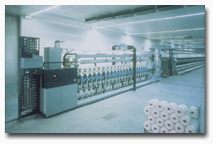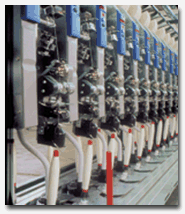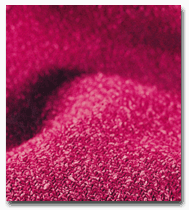Savio Macchine Tessili SpA., Italy, received strong interest at the ITMA 99 in Paris, France, for the introduction of its new Orion Automatic Winder. The Orion is the newest generation of automatic winders on the market.
Savios goal was to offer to its customers a fast, economical, reliable, and flexible automatic winder that integrates latest Computer Aided Package (CAP) build-up for perfect yarn run-offs in weaving and knitting mills, as well as most homogeneous package dyeing in dye-houses.The Orion is a winder that integrates Savio’s experiences with previous winder designs, as well as the latest hi-tech electronic control features to ensure the utmost package quality.
Flexible And Intelligent
The Orion winder features innovations that allow independent movements of important function groups. This increases efficiency and productivity due to time savings, and reduces power consumption. For example, the machine can independently move the yarn suction nozzles to find the yarn end on the package or the bobbin. Also the splicer is an independent system unit by itself.
Further, the machine has a lower consumption of compressed air due to avoidance of unnecessary splicing cycles, and reduces significantly yarn waste. Savio expects a much lower spare parts consumption because of the independent function cycles.
The new direct drive of the winding drum, in combination with many other individually driven functions, returns significant power savings. An optimized acceleration curve adapts all parameters to the actual mass (weight/size ratio) of the package, allowing faster acceleration. A customized acceleration curve for specific requirements can be preset.
Orions FlexiTray is a self-centering bobbin support which achieves a truly balanced unwinding of the yarn due to the perfect centering of the bobbin on the peg. It works even with damaged bobbin tubes. The Orion process logic can integrate all models of yarn clearers presently on the market. For stops in reference to yarn clearing, Orion’s flexible cycle minimizes production losses.
Anti-Patterning Device
For the first time, Savio introduced its revolutionary CAP system. At each winding head position the computer controls the formation of the package to avoid even the slightest yarn layer patterning.
However, only at critical diameter ratios between the drum and the package an intelligent servo command is executed. This alters the package axle position and at the same time the drive ratio between drum and package to avoid the ribboning effect.
This feature is also active during acceleration, when using cylindrical packages a tapered drum is used.
Splicing With Pride
Savio has integrated its mechanically driven splicing system for maximum splice quality. The company claims that yarn strength after spicing is 100 percent, or almost 100 percent of the original yarn strength (depending on the yarn character).
The splicer adjustment is centralized and guarantees great uniformity of splice characteristics on all individual heads. Orions Twinsplicer can handle high density yarns and Spandex yarns, and is available for Z and S-type yarns. Savio offers further the possibility to change over to alternative splicing technologies within a matter of minutes (e.g. air splicing) to adapt best to individual yarn splicing requirements.
Plenty Of Options
The optional Booster device significantly reduces the unwinding tension by modifying the shape of the unwinding balloon. In combination with the optional Tensor, an electronic yarn tension sensor, this contributes to a considerable reduction in winding tension and at the same time equalizes the pre-set tension over the entire yarn-length of the package. Should the yarn tension exceed the pre-set value, the winding drum will slow down to compensate and reduce the tension to the desired value.
The Tensor has no moving parts that could negatively influence operation and acts further as an anti-wrap/lap control, during start-up and high speed operation. Another option is the yarn waxing device with a positively driven adjustable deflection device for waxing uniformity. It features an alarm function when the wax is running out, and even stops the single winding unit if operator fails to replace the wax.
The optional bobbin cleaning system has a single suction unit for each head and is located at the height of the balloon breaker. It captures all the dust and lint that is created during the unwinding of the bobbin and is then collected by a filter.
The Savio Steaming System provides continuous steaming for improved processibility. The bobbins are guided through a tunnel which is equipped with hot-air circulation to recover heat and reconditioning of treatment water.
Automation Prepared
The automatic bobbin loader provides high-efficiency and flexibility, and at the same time offers a high loading capacity.
A wide range of tubes can be processed from 180 to 350 mm. An underwinding cleaning station allows the use of bobbins coming from spinning with automatic doffing systems. The cleaning is done before the bobbins are fitted on the pegs.
The Orion winder is prepared to link with any type of spinning machine offered on the world-wide market. A consolidated bobbin transfer system guarantees high efficiency and reliable delivery.
Other automation systems integrated in the machine are the optional tubecleaner, and the automatic package doffing. In just 15 seconds the trolley unloads the package and replaces it with an empty cone, fully prepared with a preset reserve yarn-length that is suitable for the following manufacturing processes.
Flexibility Duo-Link
The Orion even permits the user to process two different lots of materials at the same time. Each Flexitray carries an identification chip for controlling the feeding of the right bobbin to the right winding position. The recognition and distribution of the bobbins to the appropriate winding position is controlled electronically, and no physical adjustment of the individual winding heads is required since all settings are adjusted by the machine’s computer. Orion’s Duo-Link takes care of the processing of two lots coming from a double-drive spinning frame.
November 1999







